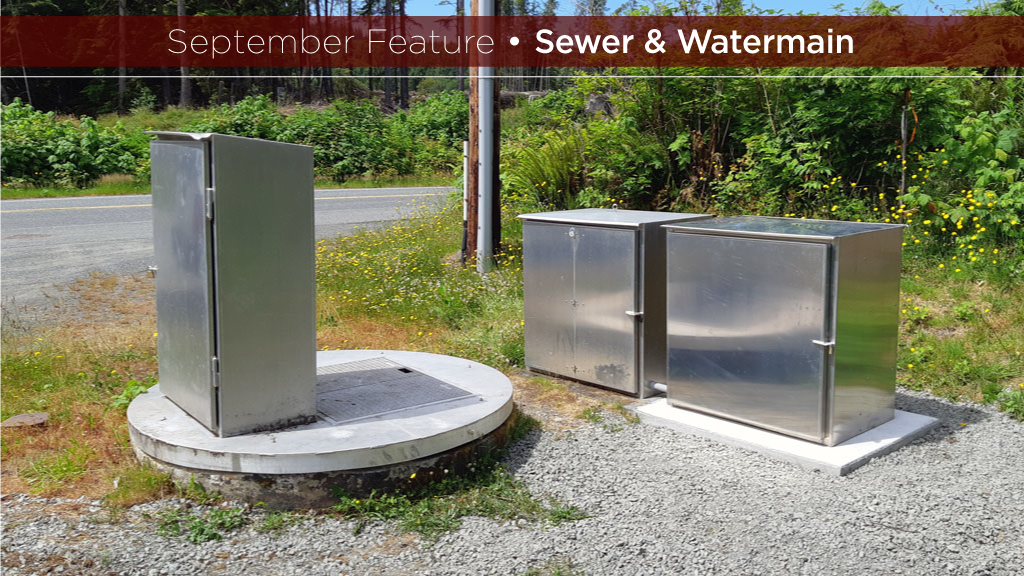Northern Vancouver Island has beautiful scenery and wildlife, but its remote location and sparse population means it also has many more power outages than the more populous areas of B.C., such as Victoria and the Lower Mainland.
Paul Getman, the water and wastewater systems operator in the remote community of Coal Harbour, says it is not uncommon to have outages of 12 or more hours several times per year, particularly in the windy winter months.
Because the wastewater operations are required by the Ministry of Environment to continue to operate during power outages, they need to be outfitted with backup power.
In Coal Harbour and nearby Sointula, the original back-up systems for the sewer pumping stations and treatment plants were three-phase diesel generators on a towable trailer.
The system operator for each system would tow the portable generator from pumping station to pumping station and then back to the treatment plant at each location.
He would do this over and over for the duration of the power outage in order to stay ahead of the sewage flows.
“To say that we were able to stay within Ministry of Environment guidelines 100 per cent of the time would be an overstatement,” says Getman.
In fall 2020, Getman’s bosses asked him to look into getting battery-powered backup systems to keep the villages’ sewer pumping stations working whenever the power went out.
“My initial feedback was that this would probably be prohibitively expensive and that the regional district should just go ahead and purchase stationary diesel backup generator sets,” Getman says. “But they insisted, so I dove into this most interesting project.”
After an extensive search, Getman discovered battery-powered units were not to be had, and no other municipalities were using anything other than diesel generator sets for backup power for their sewer pumping stations.
“In the end it became obvious that, in order to meet our requirements, we would need to build our own battery backup systems,” says Getman.
Their only hard and fast requirements were that the systems would need to cover the first 24 hours of a power outage and do it automatically.
By summer 2021 Getman had assembled a proof-of-concept backup unit of three 48 volt 10 kwh lithium iron phosphate batteries and three 3,600 watt inverters.
“The inverters instantly and automatically switch from standby to full backup power in the event of a power interruption on one or more phases,” says Getman. “It automatically switches back to recharging the batteries and standby mode when the power is restored.”
After much testing, the proof-of-concept battery backup unit worked “exactly as we had hoped” and Getman and the regional district decided to go ahead and build an additional eight units.
They also decided to build, rather than buy, 25 additional lithium iron phosphate batteries, “as this would save approximately $25,000.”
Fully assembled, each battery in its aluminum case is 24” long, by 16” deep, by 13” high and weighs in at approximately 200 pounds.The regional district also ordered aluminum containers from a local fabricator and 28 3,600-watt 48 volt DC inverters, switch gear and panels.
In order to have a place to assemble the battery backup units, they rented warehouse space from a local business.
Each battery backup unit is connected to the district’s SCADA (Supervisory Control and Data Acquisition) system and can be monitored, adjusted and send out alarms whenever necessary.
“Because all this took place in the middle of COVID, it led to some supply chain holdups,” says Getman. “Assembly of the battery backup units took over 10 months and wasn’t completed until spring 2022.”
But by the end of summer 2022 the battery backup kiosks were in service in Coal Harbour and Sointula.
The battery backup units have now been in service for two years “and are performing flawlessly,” says Getman.
“The final cost to install these battery backup units was between 150 per cent and 175 per cent of the cost to install stationary diesel generator sets. “The long-term payback will be in the minimal maintenance of these battery backup units compared to diesel generator sets. We expect these units will need battery replacement in 10 to 15 years and inverter replacement in 15 to 20 years.”
Getman says he is unaware of any other battery back-up for wastewater systems in Canada, or anywhere else.
“Frankly, I’m very surprised,” he says. “I did a thorough search on the Internet at the beginning of this project and again in the last couple of days (September 2024) and I couldn’t find anything like what we’ve built.”



Recent Comments
comments for this post are closed